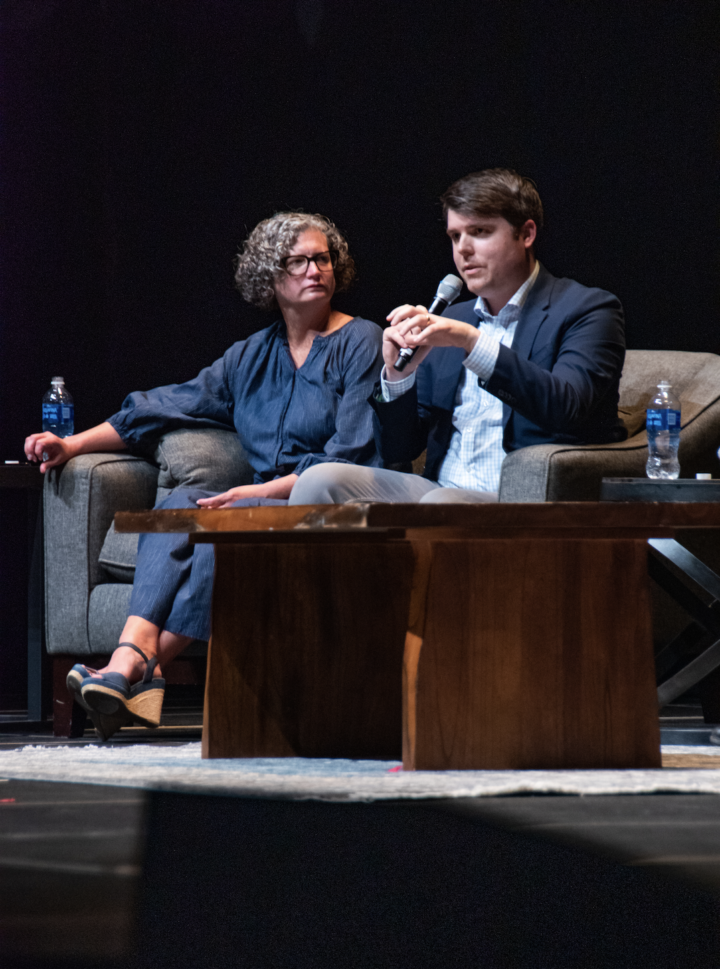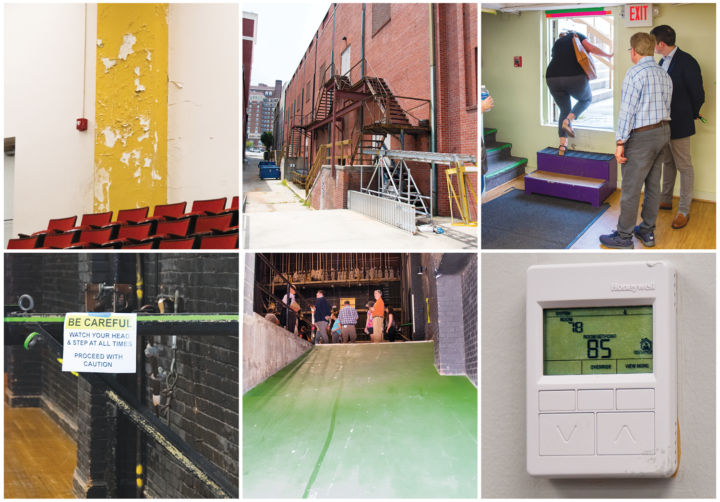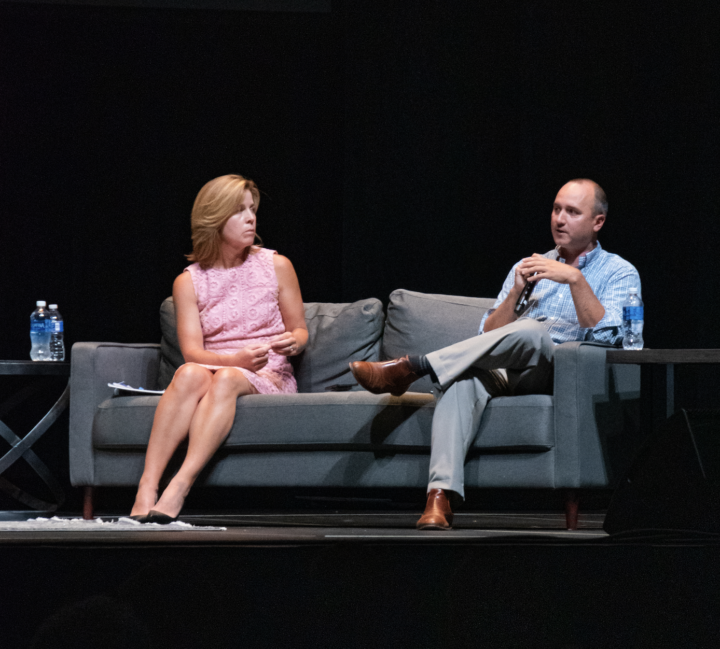For decades, touring comedians have cracked jokes about — and heads on — the tiny doorway to the basement dressing rooms of Asheville’s Thomas Wolfe Auditorium.
“The Wolfe,” as it’s come to be known, has been at the core of Asheville’s arts and music scene since 1940, including hosting the Asheville Symphony since 1968. It’s accumulated the stories and energy that decades of performances are sure to produce.

Now, with the city-owned auditorium closed to ticketed shows for the foreseeable future after its heating, ventilation and air-conditioning system failed in July, leaders in the city and local arts community are hoping this is finally the moment the Wolfe will get a makeover.
“The stars have aligned,” says Asheville Mayor Esther Manheimer about the possibilities of the auditorium’s first major renovation in almost 50 years. Conversations have started and stalled numerous times over her 14-year tenure on City Council.
For the symphony, which will play shows this season at various venues — from the First Baptist Church of Asheville to the Brevard Music Center — upgrades can’t come soon enough.
“We can weather this sort of storm for a couple of years. But if it drags on in perpetuity, the symphony is going to have a really hard time making things work,” said Daniel Crupi, executive director of the Asheville Symphony at a recent town hall event. “The status of the organization and the musicians that rely on this organization to make a living, all of that is in jeopardy. So, for us, the situation is very, very dire.”
‘Don’t pass out tonight’
In front of a sold-out show July 3, Thom Yorke of The Smile, an English rock trio consisting of two members of Radiohead, was worried about the crowd’s safety in a packed, 86-degree auditorium. Venue management was relying on fewer cooling units to make up for one that failed the previous week.
“Don’t f-ing pass out tonight,” he told the crowd, according to Matthieu Rodriguez, marketing manager for Harrah’s Cherokee Center at Asheville.
Two other HVAC units went out after that show, forcing a full closure. But heating and cooling isn’t the only thing that needs to be fixed at the 83-year-old auditorium.
From the seats, one can see paint peeling off the walls and water stains on ceiling tiles. Multiple chairs have caught fire (with no one sitting in them) due to electrical wiring issues in the house. Balcony seating doesn’t face the stage because the auditorium was originally designed to double as a sports venue with a flat floor.
But the issues go way deeper than what the average attendee can see from the audience.

For decades, Asheville has been known among touring performers for its cramped loading area along the south side of the Thomas Wolfe, according to everyone interviewed for this story. There’s barely room for one semitractor-trailer in the alley, and the ramp to the stage area is so steep that a winch system is often used to get large amps and other equipment up the 60-degree slope.
On stage, there’s not much room to store equipment or move around, which makes things particularly difficult for a large symphony orchestra, Crupi says.
“The stage can barely accommodate a smaller-sized orchestra. And we always have a really hard time getting a full orchestra and our 110-voice chorus on stage together,” he says.
And lighting, especially in the back areas of the stage, is poor. If the lighting on a particular performer is not quite right, the rig has to be lowered by hand and adjusted, Crupi says, a manual element you would not expect from a large auditorium in the 21st century.
It can be so dark backstage that several years ago, the first-chair violinist was moving a chair behind the orchestra shell before a performance when she tripped and fell, breaking her arm and wrist, recounts Mike Brubaker, longtime horn player in the Asheville Symphony. The woman played the show anyway, including a substantial violin solo, he says.
“It was remarkable. I know that she did that performance in a great deal of pain, but she’s just a consummate professional musician. She did her best under the circumstances,” he remembers.
Symphony oboe player Cara Jenkins calls that story legendary because everyone expected something like that to happen in The Wolfe at some point.
Further, bits of plaster have fallen on musicians during shows, including on the timpani drum, making concentration difficult in the midst of a complicated orchestral arrangement, to put it mildly, Brubaker says.
Beyond the stage issues, a dressing room area beneath the stage that immediately transports you to the 1970s is entered through a door that few would fit through without ducking. That has fueled bits from Jerry Seinfeld and produced bruises for Bill Maher, among others, remembers Rodriguez.
“It’s beyond old-fashioned. It’s very, very hazardous. I’ve been embarrassed for a lot of the visiting musical groups that don’t come away with a very good impression of Asheville, just because of space and conditions of the Thomas Wolfe Auditorium,” says Brubaker, who also represents musicians as chair of the orchestra committee.
Not built as a symphony hall
One upside of The Wolfe’s closure to ticketed shows, according to Jenkins, is that orchestra members will be able to actually hear themselves play in their temporary homes. In the Wolfe, they have to work extra hard to fill the room with sound because it has almost no reverberation, she says.
“It’s almost like a mixed blessing and curse to leave the Thomas Wolfe because acoustically it is horrendous. It’s such a bad hall; there is nothing that I can think of that’s worse than the Thomas Wolfe,” she says. “It doesn’t have any ring.”
First Baptist Church of Asheville, meanwhile, is structured like a fishbowl, providing almost too much reverb, Jenkins says.
The downside, of course, is the symphony will play to smaller audiences from smaller stages, meaning more shows, more expense and less money for the organization, Crupi says.
For Jenkins, the ideal scenario would be getting the acoustics of the church in an auditorium the size of the Wolfe.
In fairness to The Wolfe, it wasn’t built with a modern symphony orchestra in mind.
Thomas Wolfe Auditorium dates to the construction of a 3,000-seat Municipal Auditorium in 1940 with a flat floor capable of being converted into a ballroom. It was renowned in its time by critics for its art deco style, designed by Asheville architect Lindsey Gudger. It was designed not just for musical concerts and theatrical performances, but also as a space for “social events, athletic contests of certain kinds, and a variety of conventions and conferences,” according to the center’s website.
It wasn’t until 1975, when the civic center complex now known as Harrah’s Cherokee Center – Asheville was added, complete with a banquet hall, arena and auditorium lobby, that the Wolfe was renovated to have the sloped, or “raked” floor more suitable for regular, seated performing arts shows.

Other than basic upkeep, not much has been done to the auditorium since, leading to calls in recent years for upgrades.
A plan was underway as recently as January 2020, when conceptual designs were presented to the community in a public information session after Asheville City Council approved $500,000 for designs and budget development in 2017.
COVID eliminated the need for a large public gathering space shortly thereafter, and the conversation was dead until the HVAC went out this summer.
Chris Corl, director of community and regional entertainment facilities for the City of Asheville, estimates it will cost the city $1.2 million to fix the HVAC so that shows can return to full capacity. Corl has presented plans ranging from basic upgrades costing roughly $40 million to making The Wolfe Broadway-ready, which could run up to $200 million.
Symphony members Brubaker and Jenkins are rooting for the acoustic-driven renovation option, which could cost upward of $150 million if renovations were to start in 2028, as Corl estimates is the best-case scenario.
In the meantime, Corl plans to have the HVAC system patched for about $190,000 in order to open the auditorium in late fall for limited-capacity events.
A comfortable shoe
For local promoter Jessica Tomasin, the studio manager for Echo Mountain Recording Studios and creator of Connect Beyond Festival, The Wolfe is a unique venue worth keeping around.
“It’s such a well-worn space, it’s like putting on a pair of your favorite comfortable shoes,” she says.
She’s been to countless shows at the auditorium in the 24 years she’s lived here, and because it maintains its independence from large event promoters like Live Nation (parent of Ticketmaster), it means local promoters like herself can run events there.
The Wolfe is ideal for an event like Connect Beyond, she says, because its size and versatility mean she can show films and have live musical elements in the same room in front of a large audience. But like everyone else, she’s aware of its problems.
Tomasin compared The Wolfe to a local band on the verge of a big break. It has the chance to upgrade from touring in a minivan to an RV, and she believes it can take that leap to better gear and better digs without losing the spirit that made it successful in the first place.
“I think it will be easy to still embody that spirit of it, but also making it something that’s, you know, way more conducive for everybody that’s coming through there,” she says.
For Brubaker, who says he’s been enduring The Wolfe’s shortcomings for far too long, there’s no reason to hold back on renovations.
“If we were dealing with a theater that was, let’s say, like the Fox Theatre in Atlanta, where it had some historic value, and had originally been designed with a much larger backstage area, that would be worth restoring. No one has ever really thought of the Thomas Wolfe as a historic venue,” he says.
Over the years, the city has toyed with the idea of a full rebuild, but those in the industry agree that a 2,500-seat performing arts center is a vital element of Asheville’s arts and culture scene.
“I think that the future of the facility has got to be decided now. It can’t be postponed anymore,” Brubaker says.




Could the reporter dig a little deeper into the history of failed efforts to either renovate the Thomas Wolfe Auditorium or build a new performing arts center? This has been going on since around 1969. He may want to ask why the original bond issue promoted by the now defunct Civic Arts Council to build an arts an performance in 1969 passed but then funds were diverted for other uses.
The reporter talks with Symphony musicians but why not ask the Symphony board and leadership what plans, if any, they may have to buiild a dedicated symphony hall, to meet the requirements of live acoustic music, very different requirements from Broadway shows or amplified events?
He should investigate what happened to the $1 million that a Home Depot heiress (now departed ) contributed.
How much was spent on plans by Arca Design: https://arca-design.com/portfolio/asheville-performance-center/
How much was paid to James Badouin as executive director?
How do the histories of other cultural projects fit in? What were the hopes for the now defunct Pack Place? Why did it ultimately fail? Why did the project to build a science museum, an outgrowth of the now defunct Health Adventure, fail?
Is this a topic that requires the investigative resources of Asheville Watchdog? John Boyle’s commentary was a beginning but not really a deep dive: https://avlwatchdog.org/opinion-dillydallying-over-dilapidated-thomas-wolfe-renovation-plans-is-deja-vu-all-over-again
Could’ve had a wonderful spot with tons of parking where the New Belgium now sits …wouldn’t that be more appealing than a brewery ?
This discussion has been ongoing and nothing has changed. It is also very disheartening to understand, as per an article in Citizen Times in 2020, “Because of its age, the auditorium also does not have modern seating with clear views for Americans with Disability Act patrons.” A good healthy lawsuit will light a fire under the butts of those in charge. Anyone?
If it’s anything like the Water System “story” of Asheville and Buncombe County, it will be a “doozie”.
Since the TDA wants to take over our city and stick their name on EVERYTHING, they should start paying for EVERYTHING……
Thomas Wolfe auditorium is of historical historical significance to the city of Asheville. The location is perfect and the building, size , and acoustics are perfect for smaller concerts and activities. It is well worth preserving using our surplus of tax and local dollars. Generations of my family have gathered at the Thomas Wolfe Auditorium for lovely evening events and day events during the holidays.